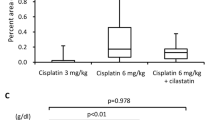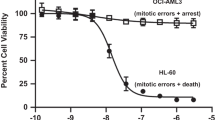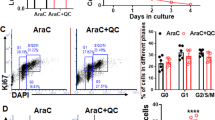Abstract
Circumvention of chemoresistance in cancer may involve several modulator drugs with high affinity for the multidrug transporter P-glycoprotein (Pgp), which is expressed in a number of multi-resistant malignancies. Pgp acts as a membrane efflux pump with broad substrate specificity including antineoplastic drugs and endogenous substances such as certain cytokines and sphingolipids. Therefore, the consequence of Pgp blockade could be far more complex than intracellular drug retention. In the present study exposure of the Pgp inhibitor, PSC 833 (1200 ng/ml), to Pgp expressing KG1a/200 human leukemia cells provoked cell cycle arrest and apoptosis in vitro. This finding was put to test in vivo using a xenotransplant model of KG1a/200 human cells intravenously inoculated into non-obese diabetic severe combined immunodeficient (NOD-SCID) mice. The animals were randomly allocated to receive treatment with PSC 833 (n = 32) or placebo (n = 24). PSC 833 (30 mg/kg) was subcutaneously injected six or 12 times separated by 48–96 h. The overall mean whole blood concentration of PSC 833 was 1191 ± 60 ng/ml (s.e.m.) at 20 h after administration. Tumor engraftment was significantly reduced in the treatment group (P = 0.037), which also had prolonged survival compared to control animals (P = 0.0016). This is the first study that demonstrates antileukemic effects of a Pgp inhibitor as single agent therapy in vivo, and the present data raise the possibility of alternative exploitation of modulators in cancer chemotherapy.
This is a preview of subscription content, access via your institution
Access options
Subscribe to this journal
Receive 12 print issues and online access
$259.00 per year
only $21.58 per issue
Buy this article
- Purchase on Springer Link
- Instant access to full article PDF
Prices may be subject to local taxes which are calculated during checkout





Similar content being viewed by others
References
Endicott JA, Ling V . The biochemistry of P-glycoprotein-mediated multidrug resistance Annu Rev Biochem 1989 58: 137–171
Juliano RL, Ling V . A surface glycoprotein modulating drug permeability in Chinese hamster ovary cell mutants Biochim Biophys Acta 1976 455: 152–162
Pastan I, Gottesman M . Multiple-drug resistance in human cancer N Engl J Med 1987 316: 1388–1393
Mulder HS, Dekker H, Pinedo HM, Lankelma J . The P-glycoprotein-mediated relative decrease in cytosolic free drug concentration is similar for several anthracyclines with varying lipophilicity Biochem Pharmacol 1995 50: 967–974
Chan HS, DeBoer G, Haddad G, Gallie BL, Ling V . Multidrug resistance in pediatric malignancies Hematol Oncol Clin North Am 1995 9: 275–318
Baldini N, Scotlandi K, Barbanti-Brodano G, Manara MC, Maurici D, Bacci G, Bertoni F, Picci P, Sottili S, Campanacci M, Serra M . Expression of P-glycoprotein in high-grade osteosarcomas in relation to clinical outcome N Engl J Med 1995 333: 1380–1385
Marie JP, Zhou DC, Gurbuxani S, Legrand O, Zittoun R . MDR1/P-glycoprotein in haematological neoplasms Eur J Cancer 1996 32A: 1034–1038
Yuen AR, Sikic BI . Multidrug resistance in lymphomas J Clin Oncol 1994 12: 2453–2459
Drach J, Gsur A, Hamilton G, Zhao S, Angerler J, Fiegl M, Zojer N, Raderer M, Haberl I, Andreeff M, Huber H . Involvement of P-glycoprotein in the transmembrane transport of interleukin-2 (IL-2), IL-4, and interferon-gamma in normal human T lymphocytes Blood 1996 88: 1747–1754
Raghu G, Park SW, Roninson IB, Mechetner EB . Monoclonal antibodies against P-glycoprotein, an MDR1 gene product, inhibit interleukin-2 release from PHA-activated lymphocytes Exp Hematol 1996 24: 1258–1264
van Helvoort A, Smith AJ, Sprong H, Fritzsche I, Schinkel AH, Borst P, van Meer G . MDR1 P-glycoprotein is a lipid translocase of broad specificity, while MDR3 P-glycoprotein specifically translocates phosphatidylcholine Cell 1996 87: 507–517
Bosch I, Dunussi-Joannopoulos K, Wu RL, Furlong ST, Croop J . Phosphatidylcholine and phosphatidylethanolamine behave as substrates of the human MDR1 P-glycoprotein Biochemistry 1997 36: 5685–5694
Ford JM, Hait WN . Pharmacology of drugs that alter multidrug resistance in cancer Pharmacol Rev 1990 42: 155–199
Ferry DR, Traunecker H, Kerr DJ . Clinical trials of P-glycoprotein reversal in solid tumours Eur J Cancer 1996 32A: 1070–1081
Twentyman PR, Bleehen NM . Resistance modification by PSC-833, a novel non-immunosuppressive cyclosporin Eur J Cancer 1991 27: 1639–1642
Hyafil F, Vergely C, Du Vignaud P, Grand-Perret T . In vitro and in vivo reversal of multidrug resistance by GF120918, an acridonecarboxamide derivative Cancer Res 1993 53: 4595–4602
Dantzig AH, Shepard RL, Cao J, Law KL, Ehlhardt WJ, Baughman TM, Bumol TF, Starling JJ . Reversal of P-glycoprotein-mediated multidrug resistance by a potent cyclopropyldibenzosuberane modulator, LY335979 Cancer Res 1996 56: 4171–4179
Mistry P, Stewart AJ, Dangerfield W, Okiji S, Liddle C, Bootle D, Plumb JA, Templeton D, Charlton P . In vitro and in vivo reversal of P-glycoprotein-mediated multidrug resistance by a novel potent modulator, XR9576 Cancer Res 2001 61: 749–758
Chauncey TR, Rankin C, Anderson JE, Chen I, Kopecky KJ, Godwin JE, Kalaycio ME, Moore DF, Shurafa MS, Petersdorf SH, Kraut EH, Leith CP, Head DR, Luthardt FW, Willman CL, Appelbaum FR . A phase I study of induction chemotherapy for older patients with newly diagnosed acute myeloid leukemia (AML) using mitoxantrone, etoposide, and the MDR modulator PSC 833: a Southwest Oncology Group study 9617 Leuk Res 2000 24: 567–574
Baekelandt M, Lehne G, Trope CG, Szanto I, Pfeiffer P, Gustavssson B, Kristensen GB . Phase I/II trial of the multidrug-resistance modulator valspodar combined with cisplatin and doxorubicin in refractory ovarian cancer J Clin Oncol 2001 19: 2983–2993
Dorr R, Karanes C, Spier C, Grogan T, Greer J, Moore J, Weinberger B, Schiller G, Pearce T, Litchman M, Dalton W, Roe D, List AF . Phase I/II study of the P-glycoprotein modulator PSC 833 in patients with acute myeloid leukemia J Clin Oncol 2001 19: 1589–1599
Fracasso PM, Brady MF, Moore DH, Walker JL, Rose PG, Letvak L, Grogan TM, McGuire WP . Phase II study of paclitaxel and valspodar (PSC 833) in refractory ovarian carcinoma: a Gynecologic Oncology Group study J Clin Oncol 2001 19: 2975–2982
Visani G, Milligan D, Leoni F, Chang J, Kelsey S, Marcus R, Powles R, Schey S, Covelli A, Isidori A, Litchman M, Piccaluga PP, Mayer H, Malagola M, Pfister C . Combined action of PSC 833 (Valspodar), a novel MDR reversing agent, with mitoxantrone, etoposide and cytarabine in poor-prognosis acute myeloid leukemia Leukemia 2001 15: 764–771
Lehne G, Rugstad HE . Cytotoxic effect of the cyclosporin PSC 833 by inhibition of P-glycoprotein in multidrug resistant leukemia cells Br J Cancer 1998 78: 593–600
Lehne G, De Angelis P, Clausen OP, Egeland T, Tsuruo T, Rugstad HE . Binding diversity of antibodies against external and internal epitopes of the multidrug resistance gene product P-glycoprotein Cytometry 1995 20: 228–237
Rehbinder C, Baneux P, Forbes D, van Herck H, Nicklas W, Rugaya Z, Winkler G . FELASA recommendations for the health monitoring of mouse, rat, hamster, gerbil, guinea pig and rabbit experimental units. Report of the Federation of European Laboratory Animal Science Associations (FELASA) Working Group on Animal Health accepted by the FELASA Board of Management, November 1995 Lab Anim 1996 30: 193–208
Bergan S, Rugstad HE, Stokke O, Bentdal O, Froysaker T, Bergan A . Cyclosporine A monitoring in patients with renal, cardiac, and liver transplants: a comparison between fluorescence polarization immunoassay and two different RIA methods Scand J Clin Lab Invest 1993 53: 471–477
Scott MG, Hock KG, Crimmins DL, Fracasso PM . HPLC method for monitoring SDZ PSC 833 in whole blood Clin Chem 1997 43: 505–510
Arguello F, Sterry JA, Zhao YZ, Alexander MR, Shoemaker RH, Cohen HJ . Two serologic markers to monitor the engraftment, growth, and treatment response of human leukemias in severe combined immunodeficient mice Blood 1996 87: 4325–4332
Lehne G . P-glycoprotein as a drug target in the treatment of multidrug resistant cancer Curr Drug Targets 2000 1: 85–99
Robinson LJ, Roberts WK, Ling TT, Lamming D, Sternberg SS, Roepe PD . Human MDR 1 protein overexpression delays the apoptotic cascade in Chinese hamster ovary fibroblasts Biochemistry 1997 36: 11169–11178
Bezombes C, Maestre N, Laurent G, Levade T, Bettaieb A, Jaffrezou JP . Restoration of TNF-alpha-induced ceramide generation and apoptosis in resistant human leukemia KG1a cells by the P-glycoprotein blocker PSC833 FASEB J 1998 12: 101–109
Smyth MJ, Krasovskis E, Sutton VR, Johnstone RW . The drug efflux protein, P-glycoprotein, additionally protects drug- resistant tumor cells from multiple forms of caspase-dependent apoptosis Proc Natl Acad Sci USA 1998 95: 7024–7029
Johnstone RW, Cretney E, Smyth MJ . P-glycoprotein protects leukemia cells against caspase-dependent, but not caspase-independent, cell death Blood 1999 93: 1075–1085
Pallis M, Russell N . P-glycoprotein expression is associated with resistance to spontaneous in vitro apoptosis in AML Leukemia 1999 13: 1468–1469
Pallis M, Russell N . P-glycoprotein plays a drug-efflux-independent role in augmenting cell survival in acute myeloblastic leukemia and is associated with modulation of a sphingomyelin-ceramide apoptotic pathway Blood 2000 95: 2897–2904
List AF, Glinsmann-Gibson B, Heaton R, Schlegel S, Guzman M, Futscher B . Cyclosporines inhibit interleukin-1-beta sectretion by the ABC1 transporter, impair leukemia self-renewal and sensitize AML progenitors to antineoplastics Blood 1998 92 (Suppl. 1): 675a
Lehne G, De Angelis P, den Boer M, Rugstad HE . Growth inhibition, cytokinesis failure and apoptosis of multidrug-resistant leukemia cells after treatment with P-glycoprotein inhibitory agents Leukemia 1999 13: 768–778
Lucci A, Han TY, Liu YY, Giuliano AE, Cabot MC . Multidrug resistance modulators and doxorubicin synergize to elevate ceramide levels and elicit apoptosis in drug-resistant cancer cells Cancer 1999 86: 300–311
Cabot MC, Giuliano AE, Han TY, Liu YY . SDZ PSC 833, the cyclosporine A analogue and multidrug resistance modulator, activates ceramide synthesis and increases vinblastine sensitivity in drug-sensitive and drug-resistant cancer cells Cancer Res 1999 59: 880–885
Azare J, Pankova-Kholmyansky I, Salnikow K, Cohen D, Flescher E . Selective susceptibility of transformed T lymphocytes to induction of apoptosis by PSC 833, an inhibitor of P-glycoprotein Oncol Res 2000 12: 315–323
Chaudhary PM, Roninson IB . Expression and activity of P-glycoprotein, a multidrug efflux pump, in human hematopoietic stem cells Cell 1991 66: 85–94
Waldner CI, Mongini C, Alvarez E, Sanchez Lockhart M, Gravisaco MJ, Hajos SE . Interleukin 2 exerts autocrine stimulation on murine T-cell leukaemia growth Br J Cancer 1997 75: 946–950
Duprez V, Lenoir G, Dautry-Varsat A . Autocrine growth stimulation of a human T-cell lymphoma line by interleukin 2 Proc Natl Acad Sci USA 1985 82: 2932–2936
Chen YZ, Gu XF, Caen JP, Han ZC . Interleukin-3 is an autocrine growth factor of human megakaryoblasts, the DAMI and MEG-01 cells Br J Haematol 1994 88: 481–487
Zhu YM, Bradbury DA, Keith FJ, Russell N . Absence of retinoblastoma protein expression results in autocrine production of interleukin-6 and promotes the autonomous growth of acute myeloid leukemia blast cells Leukemia 1994 8: 1982–1988
Paul CC, Mahrer S, McMannama K, Baumann MA . Autocrine activation of the IL-3/GM-CSF/IL-5 signaling pathway in leukemic cells Am J Hematol 1997 56: 79–85
Hannun YA . Functions of ceramide in coordinating cellular responses to stress Science 1996 274: 1855–1859
Smyth MJ, Obeid LM, Hannun YA . Ceramide: a novel lipid mediator of apoptosis Adv Pharmacol 1997 41: 133–154
Cabot MC, Han TY, Giuliano AE . The multidrug resistance modulator SDZ PSC 833 is a potent activator of cellular ceramide formation FEBS Lett 1998 431: 185–188
Boote DJ, Dennis IF, Twentyman PR, Osborne RJ, Laburte C, Hensel S, Smyth JF, Brampton MH, Bleehen NM . Phase I study of etoposide with SDZ PSC 833 as a modulator of multidrug resistance in patients with cancer J Clin Oncol 1996 14: 610–618
De Lord C, Clutterbuck R, Titley J, Ormerod M, Gordon-Smith T, Millar J, Powles R . Growth of primary human acute leukemia in severe combined immunodeficient mice Exp Hematol 1991 19: 991–993
Sawyers CL, Gishizky ML, Quan S, Golde DW, Witte ON . Propagation of human blastic myeloid leukemias in the SCID mouse Blood 1992 79: 2089–2098
Beran M, Pisa P, Kantarjian H, Porwit A, Bjorkholm M . Growth of sensitive and drug-resistant human myeloid leukemia cells in SCID mice Hematol Pathol 1994 8: 135–154
Dick JE, Sirard C, Pflumio F, Lapidot T . Murine models of normal and neoplastic human haematopoiesis Cancer Surv 1992 15: 161–181
Kamel-Reid S, Letarte M, Sirard C, Doedens M, Grunberger T, Fulop G, Freedman MH, Phillips RA, Dick JE . A model of human acute lymphoblastic leukemia in immune-deficient SCID mice Science 1989 246: 1597–1600
Shultz LD, Schweitzer PA, Christianson SW, Gott B, Schweitzer IB, Tennent B, McKenna S, Mobraaten L, Rajan TV, Greiner DL, Leiter EH . Multiple defects in innate and adaptive immunologic function in NOD/LtSz-scid mice J Immunol 1995 154: 180–191
Binder C, Tiemann M, Haase D, Humpe A, Kneba M . Isolated meningeal chloroma (granulocytic sarcoma) – a case report and review of the literature Ann Hematol 2000 79: 459–462
Acknowledgements
The authors are grateful to Randi Væråmoen for careful breeding and professional handling of the study animals. The highly competent technical assistance of Bjørg Fjell, Reidun Hauge, May Ellen Lauritsen, Bjørg Sinding Larsen, Anne Syrrist, and Janne Ugelstad is greatly appreciated. The study was supported by grants from Medinnova SF, The Norwegian Cancer Society and The Research Council of Norway.
Author information
Authors and Affiliations
Rights and permissions
About this article
Cite this article
Lehne, G., Sørensen, D., Tjønnfjord, G. et al. The cyclosporin PSC 833 increases survival and delays engraftment of human multidrug-resistant leukemia cells in xenotransplanted NOD-SCID mice. Leukemia 16, 2388–2394 (2002). https://doi.org/10.1038/sj.leu.2402663
Received:
Accepted:
Published:
Issue Date:
DOI: https://doi.org/10.1038/sj.leu.2402663
Keywords
This article is cited by
-
Relationship between therapeutic efficacy of doxorubicin-transferrin conjugate and expression of P-glycoprotein in chronic erythromyeloblastoid leukemia cells sensitive and resistant to doxorubicin
Cellular Oncology (2014)
-
Potential role of acid ceramidase in conversion of cytostatic to cytotoxic end-point in pancreatic cancer cells
Cancer Chemotherapy and Pharmacology (2013)
-
A cytotoxic ribonuclease reduces the expression level of P-glycoprotein in multidrug-resistant cell lines
Investigational New Drugs (2012)
-
ABC transporters in cancer: more than just drug efflux pumps
Nature Reviews Cancer (2010)
-
ATP-binding-cassette transporters in hematopoietic stem cells and their utility as therapeutical targets in acute and chronic myeloid leukemia
Leukemia (2007)



